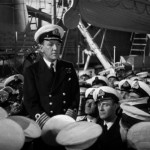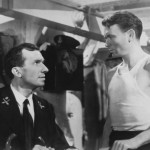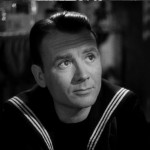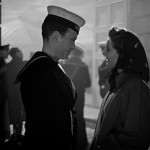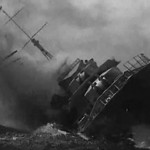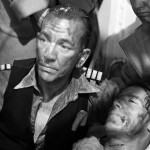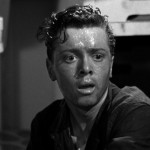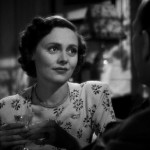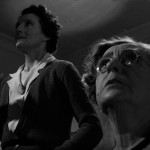
In Which We Serve – 1943
This was another war-time propaganda film, as if the title hadn’t already given that away. But this one was a bit different from the majority of the other examples I’ve seen for a few reasons. First, it was definitely a British-made film, made from a decidedly British point of view. It was about the stories of ordinary men and women from different classes, all of whom served in the Second World War with bravery and distinction in the Battle of Crete in 1941.
It was written by celebrated playwright, Noel Coward. More than that, he directed and starred in the film as well. This surprised me, because I have only ever known him as a playwright and not as an actor. As is typical in Coward’s plays, much of the dialogue is fast, smart, and witty. I suppose that is just his style. In fact, that would be one of my criticisms of the movie. Sometimes, the actors delivered their lines so fast that I had difficulty understanding what was being said.
The second thing that set this movie apart from most propaganda films of the era is the fact that it wasn’t your stereotypical Hollywood war-time action film with your attractive cast and extras. Not to put too much emphasis on the looks of the actors, but it caught my attention that the actors, from the first to the last, had very average faces. I found that little point to be significant because the lack of glamor made the stories being told more real to me than watching handsome Gary Cooper and gorgeous Ingrid Bergman fighting Germans in Spain, as in the fellow 1943 nominee, For Whom the Bell Tolls, or even watching the stunning Greer Garson and the attractive Walter Pidgeon in the 1942 Best Picture Winner, Mrs. Miniver. After all, an actor or actress’s beauty is what sets them apart from the rest of us. Take that away and they are just like us.
The film is about the British destroyer, the HMS Torrin, and the crew that manned her. Coward, himself, played Captain Kinross, and I thought he did a fine job, though, again, he needed to slow down some of his dialogue. In the first ten minutes or so of the movie, the Torrin is sunk by a barrage of German bombers. Kinross and the men under his command are forced to abandon ship. He and several of his crew, swim to a raft, though they are by no means out of danger. The main body of the film is now told in flashbacks as the various men recall their loved ones. This is where we are introduced to Mrs. Alix Kinross, played by Celia Johnson, and her children. Their story represented the upper class.
Also on the raft is Chief Petty Officer Walter Hardy, played by Bernard Miles. His memories focus on his wife Kath, played by Joyce Carey, and his aging mother-in-law, played by Dora Gregory. Their story is an important one because the two women are killed in a raid. It was a difficult scene to watch because the film did a good job of showing just how in love with each other Walter and Kath were, making the tragedy very poignant. Their story represented the middle-class.
And lastly, representing the lower class, was Ordinary Seaman Shorty Blake, played by John Mills. His back story recounts his meeting and subsequent marriage to Freda, played by Kay Walsh. While at her husband is at sea, Freda gives birth to a son. Mills actually stood out to me as one of the better actors in the film, though when it comes to it, the entire cast did a good job.
As the surviving men cling to the raft, they are slowly picked off, one by one, by gunfire from German planes, until they are rescued by another British destroyer. The final scene in which Captain Kinross address the surviving members of his crew is both emotional and restrained in that stoic, British way. The men are split up to replace killed crew members from other ships. At this point in the film, I would have liked to have seen some epilogues, telling the eventual fates of the three men, but none were given, except for one. It is revealed that Kinross goes on to command a battleship, though it never told whether or not he survived the war. I’d like to think he and the other two men did.
Much of the film’s good acting was delivered by the women. The scene where Kath Hardy and her mother are killed was particularly well done. There is an inherent tension that builds in a scene where you can hear bombs dropping in the background. The sounds gets closer and closer until the house starts to shake. By then, the sound is pretty loud, and the characters have to acknowledge that they could be killed at any moment. Then, when the moment came, it happened quickly and I was caught off guard, despite the build-up.
And, of course, the message of the film was shouted loud and clear. If anyone dear to us has been killed in the war, we should only be inspired to fight harder and with more passion. And at that time, who hadn’t lost someone dear.
